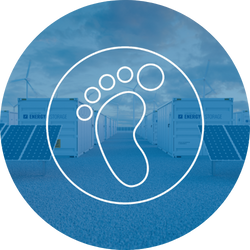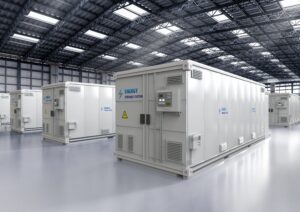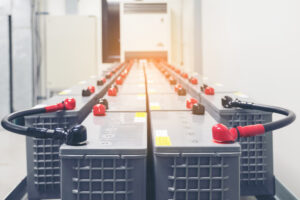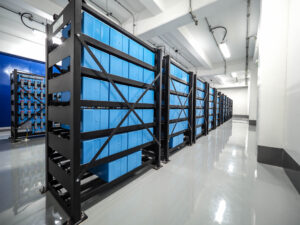Battery Storage Systems – Q&A with Kevin Byrne
Welcome to our next technology insights Q&A session, in this instalment we sat down with Senior Consultant, Kevin Byrne, to discuss the fascinating world of battery storage systems. In this insightful conversation, we will delve into the intricacies of these systems, exploring their benefits, applications, and the future of energy storage.
Battery storage systems have gained significant interest in recent years as the demand for renewable energy sources continues to rise. These systems play a crucial role in storing excess energy generated from renewable sources, allowing for a more reliable and sustainable energy supply. With the ability to store energy for later use, battery storage systems have the potential to support the wider energy transition and expand the way we manage electricity. Read on to find out more!
Q: What are the key characteristics of battery energy storage systems (BESS) and how do they work?
A battery is a chemical energy storage device. By converting the energy stored in its active materials, it can either import or absorb electrical energy in a flexible and efficient manner. Battery types are often distinguished by their active materials, each of which has its own unique characteristics. Some common examples include:
- Nickel manganese cobalt, abbreviated as NMC: and
- Lithium iron phosphate, abbreviated as LFP.
Both battery chemistries listed are lithium ion and offer materially greater energy densities than lead acid type products most people are familiar with. Both NMC and LFP batteries have seen deployment in grid connected energy storage applications. However, LFP has become the dominant chemistry deployed in this application. NMC batteries remain popular in electric vehicle applications.
Many new battery chemistries are under active development that we are following with interest, such as redox flow and solid lithium batteries.
A stationary battery, packaged with all of its structural, control, and cooling elements is typically referred to as a battery energy storage system (BESS). BESS units are modular, which makes scaling BESS developments possible. A BESS unit exports or imports power in direct current (DC) form only and needs the support of an inverter to convert this to alternating current (AC) used on the grid. When connected to the grid, a BESS unit can be used to quickly (factions of a second) respond to a request to import or export power. BESS systems are also widely deployed to provide reliable dynamic response to power grid events, where they respond in a manner proportional to the level of power grid event (such as under frequency) to ensure system stability.
Q: How can battery storage systems help to improve the resilience of our electricity network?
Achieving net zero carbon emissions from our electricity systems will require a lot of technical challenges to be overcome, and of these regards the stability of the electrical grid. Traditional power stations utilise large and heavy steam and gas turbines rotating at high speed to generate power. These turbines are synchronised with the grid, and using their inertia, help resist against any sudden changes to electricity grid frequency. With the closure of coal and gas power plants, and the increasing role of non-synchronous generators such as wind turbines and solar photovoltaics, other means of maintaining grid stability are needed.
BESS has a significant role to play helping to fill this stability gap. As BESS is capable of importing and exporting power on demand, it is ideally placed to provide rapid and dynamic responses to grid fluctuations, these precise actions of BESS plants are vital.
Most of the BESS projects that we have supported to date have been deployed in electrical grid resilience applications and have played a vital role in ensuring the resilience of the power grid as we transition to net zero carbon.
Q: How can battery storage integration with renewable energy sources support the UK & Ireland on the road to net zero?
From the end of 2022, we have seen an increase in the volume of new BESS projects deployed into more conventional power shifting applications. These projects are typically either standalone or collocated designs.
Standalone projects can be deployed to shift power from one part of the day to another, in response to market conditions (merchant trading). For example, a BESS plant may stock up on power at solar noon when power generation from photovoltaics is plentiful (and potentially cheap), and then export this power in the afternoon when power demand peaks, but solar power has dropped off. This could be a vital solution to the power demand “duck curve” which calls for non-solar power sources to ramp down or shut off rapidly to ensure that solar power is fully utilised.
BESS can be collocated with a wide range of technologies that help them to achieve their performance objectives. For example, renewable projects with variable outputs can use collocated BESS units to store their peak power output and allow the plant to spread its power export out more evenly throughout the day, making more efficient use of its grid connection.
Conversely, BESS can also be used to support electricity consumers that have peak power loads that may be greater than their grid connections. For example, an electric vehicle charging station may use BESS to level out its demand over the day and ensure that it has sufficient power on hand (though a combination of locally stored and imported power) to meet its peak demand load reliably.
Using BESS to balance peak power generation and consumption also has the benefit of removing congestion from the electricity transmission systems and facilitating the net zero carbon transition.
Q: What are the key considerations for organisations looking to invest in BESS technologies?
We support Clients with BESS projects in a wide range of applications. When considering developing a BESS project, we believe two of the most important first steps regards;
- understanding the likely use case of the project (specifically the number of cycles and hours of storage required); and
- the status and capacity of the grid connection applied for or secured.
An early understanding of the likely use case of the BESS project is essential. This informs the type of BESS technology to be used, the projects useful life, and the layout and configuration of the project. We believe that early engagement with the likely power off-takers, trading partners, or economic advisors to ascertain this information is critical to determining the design objectives of a BESS project.
Many energy transition projects are experiencing significant project delays associated with prolonged grid connection lead times. We also suggest that clients ensure that they have an understanding the likely grid connection lead times early in project development and confirm that it suits its project objectives.
For BESS applications under commissioning, or that have entered operation, we believe that it is important to have comprehensive and enforceable guarantees around the performance of the BESS. The guarantees should be supported with regular performance testing and inspection to allow for early rectification of issues. These mechanisms are important to ensuring that once in operation, the owner of the asset has the protections in place to ensure that it can meet the requirements of its commercial obligations.
Q: Fire Safety is often raised as a challenge for BESS technologies, what measure can be put in place to improve BESS project safety?
During regular operation, it is possible for manufacturing flaws, physical damage to the modules, or “hot spots” between the battery racks to initiate a fire within the BESS unit. Under a best case scenario, mitigation measures included in the design of the BESS (such as cell off gas detection) identify early signs of potential fire before they occur and suitable actions can be taken to resolve the issue before material equipment damage occurs, such as shutting down the unit and replacing the defective module. In some cases where a fire has occurred, it may be possible to extinguish it via an aerosol sprinkler-based solution. However, there always remains a worst case scenario where the active measures put in place are not sufficient to prevent a BESS fire.
We recommend to developers that the most effective measure to limit asset loss due to a BESS equipment fire are passive measures. Passive measures to not depend on the reliable operation of extinguishing systems, and require no interaction by the operator or third parties (such as the fire service) to limit damage. Passive measures include suitable spacing of the BESS units from each other, and incorporation of industry best practice mitigation measures such as fire walls where suitable spacing cannot be provided.





Our Energy Storage team have a comprehensive track record of successfully supporting battery storage projects throughout all stages of the technology lifecycle.
Find out more about the services we provide here.











